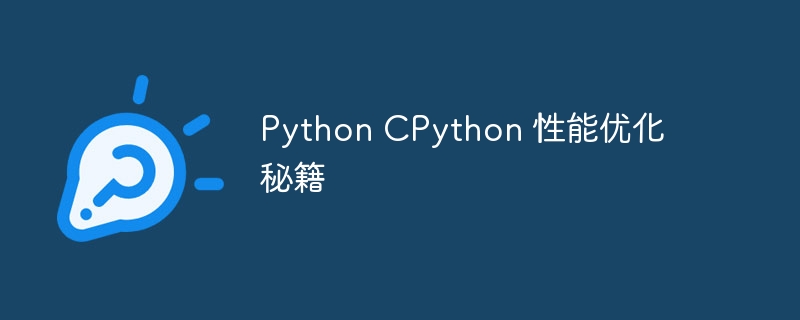Home >Backend Development >Python Tutorial >Python CPython performance optimization tips
Python CPython performance optimization tips
- WBOYWBOYWBOYWBOYWBOYWBOYWBOYWBOYWBOYWBOYWBOYWBOYWBforward
- 2024-03-06 18:04:061414browse

#python is widely used in various fields and is highly regarded for its ease of use and powerful functions. However, its performance can become a bottleneck in some cases. Through an in-depth understanding of CPython Virtual Machine and some clever Optimization techniques, the running efficiency of Python programs can be significantly improved.
1. Understand the CPython virtual machine
CPython is the most popular implementation of Python, which uses a virtual machine (VM) to execute Python code. The VM interprets bytecodes into machine instructions, which incurs a certain amount of time overhead. Understanding how VMs work helps us identify and optimize performance bottlenecks.
2. Garbage collection
Python uses a reference counting mechanism for garbage collection, but it may cause periodic garbage collection pauses, thus affecting the responsiveness of the program. To lessen the impact, you can use the following techniques:
-
Use
delRelease objects that are no longer used: Release objects that are no longer needed early to reduce the burden of garbage collection. - Use weak references: Use weak references to cache objects, and the system will automatically release them when they are no longer used.
- Disable circular references: Avoid forming circular references between objects, which will cause them to never be released.
3. Global Interpreter Lock (GIL)
The GIL is a mechanism that allows only one thread to execute Python code at a time. This may limit the parallelism of multithreaded programs. Although CPython 3.11 introduces partial GIL release, the following optimization tips still need to be considered:
- Use a thread pool: Batch tasks and execute them asynchronously via a thread pool .
- Use C extensions: Write C extensions for critical code, bypassing the GIL.
- Consider using other interpreters: such as PyPy or Jython, which use different GIL implementations or do not use the GIL at all.
4. Optimize data structures and algorithms
Appropriate data structures and algorithms are crucial to program performance. Choose the best data structure according to specific needs, for example:
- List: For sequential access and modification.
- Tuple: For immutable data.
- Dictionary: For quick search and insertion.
- Collection: Used for quick membership testing .
5. Code analysis and optimization
Use a performance analysis tool such as cProfile or LineProfiler to identify performance bottlenecks in your program. Perform targeted optimizations by refactoring code, simplifying algorithms, or using more optimized libraries.
6. Use optimized libraries
There are many optimized libraries in the Python ecosystem that can be used to improve performance. For example:
- NumPy: is used for numerical calculations.
- SciPy: is used for scientific computing.
- Pandas: Used for data analysis and manipulation.
7. Avoid unnecessary duplication
Avoid unnecessary copying of objects in Python. Use the copy and deepcopy functions to copy only when needed.
Demo code:
# 使用 `del` 释放不再需要的对象
my_dict = {"key": "value"}
del my_dict
# 使用弱引用对缓存对象进行引用
from weakref import WeakKeyDictionary
cache = WeakKeyDictionary()
cache[my_obj] = "data"
# 使用线程池异步执行任务
from concurrent.futures import ThreadPoolExecutor
with ThreadPoolExecutor() as executor:
results = executor.map(my_function, my_inputs)
in conclusion
By understanding the CPython virtual machine, adopting garbage collection optimization strategies, avoiding the impact of GIL, optimizing data structures and algorithms, utilizing optimized libraries, and avoiding unnecessary copies, we can effectively improve the performance of Python programs. These tips can help devers create smoother, more responsive applications that take full advantage of the power of Python.
The above is the detailed content of Python CPython performance optimization tips. For more information, please follow other related articles on the PHP Chinese website!
Related articles
See more- Introduction to the use of HTML parsing component HtmlAgilityPack
- Introduction to PHP garbage collection mechanism (gc)
- Practice (1)--MySQL performance optimization
- How does Angular optimize? A brief analysis of performance optimization solutions
- Getting started with the Python GIL: How to understand and use the global interpreter lock

